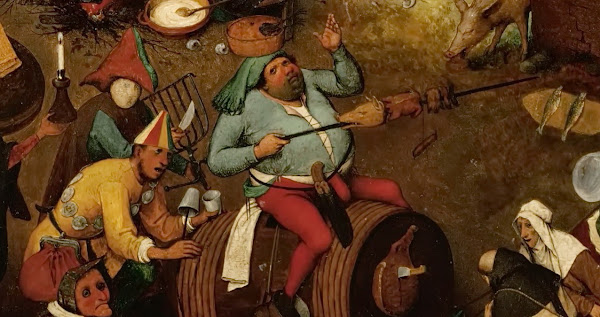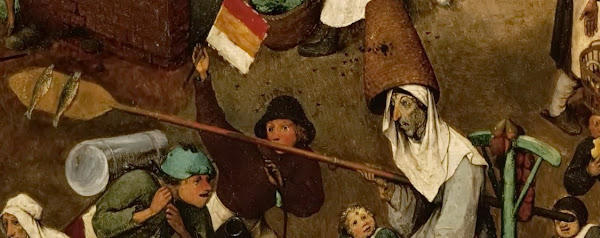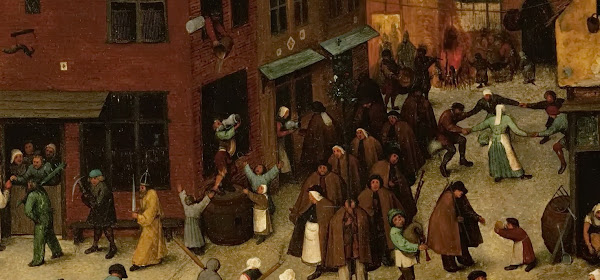Her description of "The fight between Carnival and Lent" did intrigue me:
If we imagine the Fool, the representative of Lent, running alongside the procession and calling his warnings to the riders in the cars, we can assume that they talked back to him. Happy bits of repartee would please the crowds and encourage the actors to do even better. Finally the representative of Lent might invite King Carnival to leave the safety of his car and fight like a man. (7) Then we would have a scene such as Breughel shows us in his painting "The Battle between Carnival and Lent," where jolly fat Carnival sits on a wine barrel. With a spitted goose for his weapon, he fights the representative of Lent, in this case an old woman like the Popess of the tarocchi, who had to take the place of the Fool when the latter eventually assumed the guise of Carnival King. In Breughel's painting we see in one corner a comedy troupe engaged in playing "The Dirty Bride", and observe that they look very much like characters who were originally part of our triumphal procession.Here is the detail she is talking about (from https://en.wikipedia.org/wiki/The_Fight ... l_and_Lent):

Offhand, I'd say that the fat, oblivious figure of Carnival does not look a bit like either the gaunt, somber "Bagatino" of the PMB or the thin, disheveled wreck of a Fool:

However the man in back of him in yellow at least has "Bagatino's" cups and stick; his color, yellow, is that of deceit, Wikipedia says, first of Carnival and then the man in yellow:
He is wearing a huge meat pie as a head-dress; he is wielding a long spit, complete with a pig's head, as a weapon for the fight. The pouch of knives at his belt indicates that he is a butcher - the guild of butchers traditionally provided the meat for the carnival feast so his place at the procession's heart is apt.[7] The man behind the barrel is dressed in yellow, which is connected with deceit, and he is followed by a female figure who is carrying on her head a table with bread and waffles on it.They don't say what waffles indicate.I expect it is a joke about game boards. The image of deceit more fits other images of that time and place, notably the Bosch workshop's "Conjurer", a painting filled not just with illusion but deceit (the pickpockets, at least) (https://en.wikipedia.org/wiki/The_Conjurer_(painting)). The PMB figure, however, is not yellow but red.
Nor does the personification of Lent look much like the PMB Matto, although I do admit a likeness to the Popess.

She (or is it a he with stubble on his face?) looks to me like a parody of the religious fanatic. Neither has any parodies of kingly attributes. Wikipedia calls them Carnival and Lady Lent. The latter's hat, as well as her dress, is somewhat reminiscent of the PMB Popess's tiara.
She is not much like Bosch's equivalent of the PMB Matto, namely, his two "Wayfarer" figures, with their sticks very similar to the PMB's (https://en.wikipedia.org/wiki/The_Wayfarer, https://en.wikipedia.org/wiki/The_Haywain_Triptych (scroll down to "shutters"). If there is any relationship to the tarot, the suggestion would be that of the "Fool's Journey", toward an uncertain future.
More like Bosch's wayfarers--and some tarot Fools, too, in the 16th century (Cary Sheet as a proto-TDM, Rosenwald Fool/Bagat) is the Fool who gingerly leads an "Everyman" couple through life. Wikipedia is rather disparaging about the couple, saying that the bulge on the man's back represents egotism and the woman's unlit lantern represents lack of reason, and the fool's lit torch represents dispute and destruction. It seems to me more positive than that, a symbol of light in the darkness. That he is leading them through the middle of the scene (next to the well that both sides share) indicates the avoidance of the two extremes.

There is one procession in the painting, apparently religious people all dressed alike invading Carnival. That kind of procession is believable to me.

But it is only generically related to the tarot sequence. And whatever the resemblances in the painting otherwise, it was long after the cards were already established.
No comments:
Post a Comment